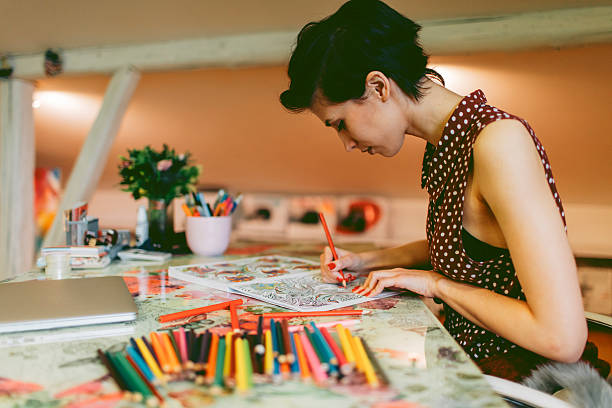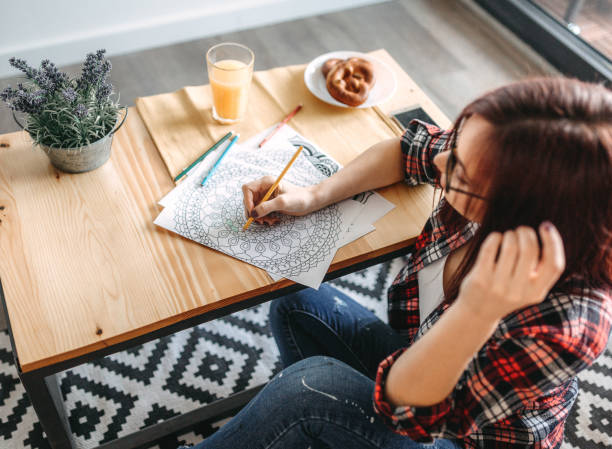
Colouring books are super popular now. Kids and adults love them for fun or to chill out. If you’re an artist or someone just starting, knowing how to make a great colouring book print matters. Including a well-designed back cover is crucial in the printing process. The front cover is equally important as it grabs your audience’s attention.
Getting your custom colouring books right involves many choices. You need to think about the binding, page size, cover, and pages inside. This guide gives you the top 10 tips to make your book look amazing and be easy to use.
Key Takeaways
- Understand the advantages of different binding styles, such as saddle-stitched, perfect bound, and spiral coil, to choose the best option for your colouring book.
- Determine the optimal page count and dimensions to maximise production efficiency and create a high-quality, professional-looking colouring book.
- Incorporate full-colour covers and upgraded paper stocks for the inside pages to enhance the visual appeal and user experience of your colouring book.
- Explore finishing touches like perforated pages, corner rounding, and shrink-wrapping to add value and convenience for your readers.
- Embrace the creative potential of colouring books by transforming the pages into unique artworks, canvas prints, and mixed media projects.
Unleash Your Creativity with Coloring Books

Coloring books are not just for kids anymore. Adults are finding them a great way to relax and get inspired. Coloring is more than just filling in the pages according to the first source. It can be used in many creative ways. To create artwork for a coloring book, consider techniques for hand-drawn or digital artwork, file requirements for printing, and cover design and lamination.
From Stress Relief to Artistic Inspiration
Many adults feel is calming and helps reduce stress. By using coloring books, adults can find new ways to be creative. This includes getting better at drawing or using them for other art like watercolors and collages.
Turning Coloring Pages into Personalized Designs
The first source gives tips on making coloring book pages into unique designs. You can use these designs for many things, including gifts and selling your creations. Just make sure you’re okay with any rules before selling your designs.
Age Group Targeted Number of Pages Paperback Format Dimensions ASIN Publisher Language ISBN-13 Paper Thickness 8-12 years 103 Paperback 21.59 x 0.61 x 27.94 cm B0CFCX6XDM Independently published English 979-8856946658 Thick, bleed-resistant pages for various coloring materials
Perfecting Your Coloring Book Print Job
Creating an amazing coloring book involves careful choices in binding, size, page count, and the quality of the interior pages. These aspects greatly affect how the book looks and feels to the user. Choosing the right paper types is also crucial for printing a coloring book, as it impacts absorbency, thickness, and suitability for coloring. By paying attention to these details, creators ensure their books are a joy to use and look at.
Choosing the Right Binding Style
Choosing a binding style is key when making a coloring book. As the second source notes, perfect binding is a well-liked choice. It uses adhesive to bind the pages and offers a sleek finish. This way, the book opens flat, making it easy to colour in. However, some might prefer plastic spiral or wire-o bindings, which offer their own benefits. Saddle stitch is another option, where sheets are folded, stacked, and stapled together down the curved edge, providing a cost-effective and durable binding style suitable for booklets and standard paperback books.
Determining the Optimal Dimensions
The standard size for a coloring book is 8.5×11 inches, yet you can get creative with other sizes. The second source points out sizes like 8×8, 9×12, or 11×14 inches. These choices allow you to tailor the book for different demographics and enhance the coloring experience. When choosing the size, think about who will use it and the complexity of the artwork.
Selecting the Appropriate Page Count
The number of pages in a coloring book matters a lot. According to the second source, books usually have between 16 to 60 pages. This range offers ample space for a variety of designs and content. Choosing the right number depends on several factors, such as who the book is for and its theme. For instance, books designed for kids might have fewer pages than those for adults.
Coloring Book Printing Considerations Details Binding Style Perfect binding, plastic spiral binding, wire-o binding Dimensions Standard 8.5×11 inches, with variations like 8×8 inches, 9×12 inches, or 11×14 inches Page Count Typically ranging from 16 to 60 pages Paper Thickness 70-100 lbs (100-150 gsm) to prevent bleed-through and provide suitable thickness for coloring Paper Texture Smooth or textured, based on personal preference and design requirements Artwork Resolution At least 600 DPI for line art, 300 DPI for cover art
Enhancing Visual Appeal of your Colouring Book Print
Turning a coloring book into a real eye-catcher involves thinking about different design parts. The second source points out how crucial it is to boost the look, especially the cover. A great cover grabs people’s attention, making them want to own it.
Additionally, adding trim lines to define the final dimensions of the finished page is essential. Trim lines ensure that necessary elements of the images stop at least 10 mm short of the trim line, allowing for a clear and precise final print.
Incorporating Full-Color Covers
The cover is a coloring book’s first impression, so it must be exciting. A full-color cover really makes the book stand out. It tells a lot about what’s inside and is also great for advertising, online or offline.
Utilizing Upgraded Paper Stocks
The paper type in a coloring book affects how it looks and feels to use. The right paper offers better color and detail. Choosing premium paper, like heavy, smooth types, improves both the look and the book’s life.
Paper Characteristic Importance for Coloring Books Texture Affects the interaction between the coloring medium and the page, influencing the vibrancy and detail of the final artwork. Weight Heavier paper stocks (70-100 lbs) help prevent color bleed-through and support more intense coloring techniques. Absorbency Determines the level of color saturation and how easily the coloring medium blends on the page.
Choosing the right paper features helps make the book more appealing and fun to use. It betters the coloring journey for everyone who picks it up. Using 150gsm uncoated paper is particularly beneficial as it prevents ink bleed-through and allows for writing or coloring on the paper.
Considering Finishing Touches for your Colouring Book Print
Adding special touches can greatly enhance a colouring book’s look and feel. The third source suggests several ways to improve it. These can really make it stand out.
Maintaining a good balance in paper qualities, such as strength, absorbency, and brightness, is crucial to avoid ink bleed-through and make the coloring experience ideal.
Perforating Pages for Easy Removal
One great idea is to make the pages easy to tear out. Pages near the spine can be perforated for this. It lets people take out a page to colour on it elsewhere or to show their work.
Corner Rounding for Safety
Rounding the corners is another smart move. It makes the colouring book look better and is safer for kids. No sharp corners mean less chance of getting hurt while they colour.
Shrink-Wrapping for Protection and Convenience
The source also suggests shrink-wrapping the books. This protects them and makes them easy to handle and store. It ensures the book stays in good shape and looks new.
Colouring Book Print: Unleashing Endless Possibilities

Colouring books offer joys beyond just intricate designs. The turns into wonderful art. It becomes stunning watercolor, mixed media, and canvas art.
From Watercolor Wonders to Mixed Media Masterpieces
Use watercolour paints to make pages amazing. Photocopy the page onto quality watercolour paper. The result is a beautiful mix of colour. It shows off your and artistic skills.
Transforming Pages into Canvas Art
Turn your colouring into lasting canvas art. Stick the page onto a canvas and varnish it. This protects and enhances your creation. It gives the original a new look.
Collaging with Coloring Book Elements
Use colouring book pages in mixed media art. Cut and layer elements for unique compositions. This lets you blend the familiar with the new. Explore your and skills in endless ways.
Elevating Your Colouring Book Print Designs
The adult colouring book industry is booming. This means your designs need to be top-notch to stand out. Key things that make your books more attractive and sell well are clean, high-resolution art and keeping the pages looking the same.
Creating Clean, High-Resolution Artwork
The artwork in your colouring books must be top quality. Make sure your designs are clear, smooth, and have strong contrast. Good resolution is also very important. This not only makes your book look better but also makes colouring enjoyable. Spend time making your designs perfect, so everyone loves colouring them, from kids to adults.
Maintaining Consistent Page Orientation
It’s also key to keep the page layout the same throughout your colouring book. You may choose the usual up and down style or get creative with different layouts. No matter what, keep the look consistent. This makes your book look polished. Plus, it helps users focus on colouring without any distractions.
Attribute Value Publisher MIRA Edition First (20 October 2016) Language English Paperback 96 pages ISBN-10 0008203547 ISBN-13 978-0008203542 Dimensions 24.1 x 0.8 x 23.6 cm Customer Reviews 4.2 out of 5 stars, based on 37 ratings
Colouring Book Print – Optimizing for User Experience
Making the colouring book experience top-notch is crucial for success. The second source reveals key elements for making fans of colouring happy.
Printing Designs on One Side Only
It’s vital to print designs on just one page side. This decision brings two major pluses. Firstly, it stops colours from seeping through. This way, the artwork stays pristine. Plus, it’s easier to tear out pages without ruining the other side.
Allowing Ample Gutter Margin
Having lots of gutter margin is important. It gives users room to grip the page while colouring. This doesn’t spoil the artwork. A balanced look with good margins adds to the book’s beauty and makes it user-friendly.
Cover Design Essentials

The cover design of a colouring book is vital. It’s the first thing people see. It should make a powerful and lasting impression. A full-color cover can make your book look better, both in stores and online. The inside front cover also plays a crucial role in the overall cover design and binding process, adding to the book’s durability and aesthetic appeal.
Enhancing with Foil-Stamping and Embossing
Think about using foil-stamping or embossing to make your cover special. These techniques can add elegance. They help your book look different from others. The shiny or raised parts on your cover can catch the eye of anyone looking at it.
Applying Protective Laminates
Protecting the cover is important for its long life. A protective laminate can keep your colouring book looking new, even with a lot of use. It also guards against spills and fingerprints. This makes using the book a better experience.








